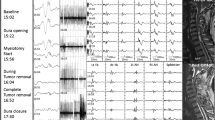Abstract
Objective
The objective of this review is to discuss the utilization of intraoperative neurophysiological monitoring (IONM) during spinal cord tumor surgery.
Discussion
The literature generally supports the use of intraoperative monitoring during surgery for spinal cord lesions.
Conclusion
We argue that IONM should be the standard of care for the treatment of such pathology, and a number of issues supporting this argument are discussed.

Similar content being viewed by others
References
Brown RH, Nash CL Jr (1979) Current status of spinal cord monitoring. Spine 4:466–470
Moser FG, Tuvia J, Lasalla P, Llana J (1992) Ependymoma of the spinal nerve root: case report. Neurosurgery 31:962–964
Zornow MH, Grafe MR, Tybor C, Swenson MR (1990) Preservation of evoked potentials in a case of anterior spinal artery syndrome. EEG Clin Neurophysiol 77:137–139
Morota N, Deletis V, Constantini S, Kofler M, Cohen H, Epstein FJ (1997) The role of motor evoked potentials during surgery for intramedullary spinal cord tumors. Neurosurgery 41:1327–1336
Kothbauer K, Deletis V, Epstein FJ (1997) Intraoperative spinal cord monitoring for intramedullary surgery: an essential adjunct. Ped Neurosurg 26:247–254
Schwartz DM, Auerbach JD, Dormans JP, Flynn J, Drummond DS, Bowe JA, Laufer S, Shah SA, Bowen JR, Pizzutillo PD, Jones KJ, Drummond DS (2007) Neurophysiological detection of impending spinal cord injury during scoliosis surgery. J Bone Joint Surg Am 89:2440–2449
Nuwer MR, Dawson EG, Carlson LG, Kanim LE, Sherman JE (1995) Somatosensory evoked potential spinal cord monitoring reduces neurologic deficits after scoliosis surgery: results of a large multicenter survey. Electroencephalogr Clin Neurophysiol 96:6–11
Sala F, Dvorak J, Faccioli F (2007) Cost effectiveness of multimodal intraoperative monitoring during spine surgery. Eur Spine J 16:S229–S231
National Spinal Cord Injury Statistical Center N (2008) Spinal cord injury: facts and figures at a glance. http://www.spinalcord.uab.edu
Kalkman CJ, Drummond JC et al (1991) Low concentrations of isoflurane abolish motor evoked responses to transcranial electrical stimulation during nitrous oxide/opioid anesthesia in humans. Anesth Analg 73(4):410–415
Zentner J, Albrecht T et al (1992) Influence of halothane, enflurane, and isoflurane on motor evoked potentials. Neurosurgery 31(2):298–305
Sakamoto T, Kawaguchi M et al (2001) Suppressive effect of nitrous oxide on motor evoked potentials can be reversed by train stimulation in rabbits under ketamine/fetanyl anaesthesia, but not with additional propofol. Br J Anaesth 86(3):395–402
Nathan N, Tabaraud F et al (2003) Influence of propofol concentrations on multipulse transcranial motor evoked potentials. Br J Anaesth 91(4):493–497
Kawaguchi M, Sakamoto T et al (2000) Low dose propofol as a supplement to ketamine-based anesthesia during intraoperative monitoring of motor-evoked potentials. Spine 25(8):974–979
Yakovlev PL, Lecours AR (1967) The myelogenetic cycles of regional maturation of the brain. In: Minkowski A (ed) Regional development of the brain in early life. Davis, Philadelphia, pp 3–70
Epstein F, Epstein N (1981) Surgical management of holocord intramedullary spinal cord astrocytomas in children. J Neurosurg 54:829–832
Epstein F, Epstein N (1982) Surgical treatment of spinal cord astroyctomas. J Neurosurg 57:685–689
Steinbok P, Cochrane DD, Poskitt K (1992) Intramedullary spinal cord tumors in children. Neurosurg Clin North Am 3:931–945
Kothbauer KF, Deletis V, Epstein FJ (1998) Motor-evoked potential monitoring for intramedullary spinal cord tumor surgery: correlation of clinical and neurophysiological data in a series of 100 consecutive procedures. Neurosurg Focus 4. http://www.aans.org/journals/online_j/may98/4-5-1
McGirt MJ, Goldstein IM, Chaichana KL, Tobias ME, Kothbauer KF, Jallo GI (2008) Extent of surgical resection of malignant astrocytomas of the spinal cord: outcome analysis of 35 patients. Neurosurgery 63:55–61
Author information
Authors and Affiliations
Corresponding author
Rights and permissions
About this article
Cite this article
Hsu, W., Bettegowda, C. & Jallo, G.I. Intramedullary spinal cord tumor surgery: can we do it without intraoperative neurophysiological monitoring?. Childs Nerv Syst 26, 241–245 (2010). https://doi.org/10.1007/s00381-009-1022-4
Received:
Published:
Issue Date:
DOI: https://doi.org/10.1007/s00381-009-1022-4




